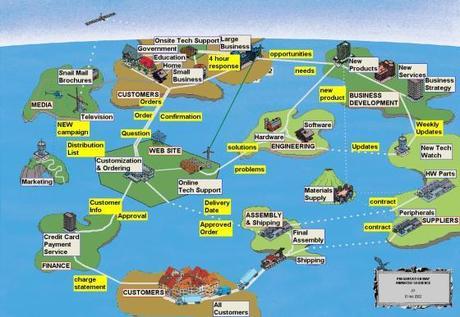
Children tend to think visually until they learn to read and write. Then sadly, many never use that tremendous mind capacity again for the rest of their lives. Many adult are not able to visualize things, like a traffic accident or carnival procession. Let alone higher level concepts as social welfare, health service, innovative business models, new products, etc.
That is not very surprising, given the fact that until recently it was not technically possible or too costly to use images, sketches, schemes, block diagrams, colours, music, photos, and films in written material. The context was defined by the possibilities of the printed book as invented by Gutenberg in 1436, and as adults we become more and more accustomed to think in words only.
However, there is no reason anymore for thinking and communicating exclusively in words. The technology is there, but it is disappointing that we seldom use it.
- A computer is not as standard provided with a device to sketch – a device that can be seamless used with a word-processor;
- It is still rather complicated to insert films and pictures in blogs;
- Even for making scripts for movies, an eminent visual medium, writing software is not yet equipped with the possibility to insert illustrations like mood boards, films, audio fragments or images;
- In Word it is complicated to get neat cause-effect schemes;
- Although there are spectacular mind map software programs, there is no possibility to have text and mind map integrated in one document;
- There are no software programs available anymore that have the possibility to draw geographic maps, to help thinking about complex cooperation processes or information flows, and prevent intellectualizing, jargon and woolly language or even thinking;
- In official documents and papers, images, colour, and typography is still seldom used.
- E-books are poor electronic clones of paper books. The standard e-book formats do not allow the full making use of the possibilities of the digital era. This is an example of designing something new, but the design is subdued by thinking in standard logic bubbles (that is the printed word is more important).

Thinking visually is not to be confused with visualizing. Visual thinking is non-verbal thought – thinking in pictures. Creative visualization, also called sport visualization, is the basic technique to attain goals by imaging that it already happened. Visual thinking is also different from information visualization: the (interactive) visual representation of data. But all have in common the involvement of the right brain hemisphere, what is thought to be specialized in non-sequential, simultaneously thinking and synthesizing the bigger picture. See also our blog about right and left side thinking. However, the left hemisphere is also most likely involved.
Although the development of tools for visualization is very slowly, there are some hopeful trends.
- Nowadays mind map software is available (see overview) as software for outlining thinking as in Rationale or Inspiration ;
- The book “ A Whole New Mind – Why right-Brainers will rule the future” by Daniel Pink illustrates a general movement in management literature to increasingly accept creativity and innovation as a source of business value;
- In the near future, many websites will be converted to make a more efficient use of photos and illustrations, and even videos;
- Nowadays many schoolbooks are colourful and attractive illustrated ;
- Just a year ago, Pinterest was launched, a content sharing service that allows members to “pin” images, videos and other objects to their pin-board. We made the subject of our Thinkibility books available here, only using pictures.
- The increasing use of “infographics”;
- The emergence of system thinking, even on high schools now. System thinking is not possible without making a visual representation of relations between the parts of the system;
- New business models are hardly understandable, unless it is explained visually. For examples, see here.
As the inter-dependencies at any system level only increases and available information rise exponentially, we will desperately need different tools to support us in our daily practice. In spite of all computer technology, we can benefit from learning to express ourselves visually.
Is it necessary or even possible to block out the left hemisphere? Well, take a picture, turn it upside down, close your right eye (if you are right-handed), observe, and draw. Or take a 2 hours class from Betty Edwards: “Drawing on the Right Side of the Brain”.
Photo: “Alphabet Drawing Business Plan Concept Ideas” by KROMKRATHOG
